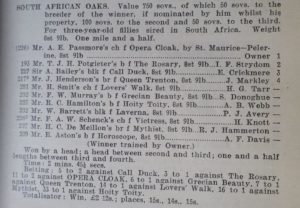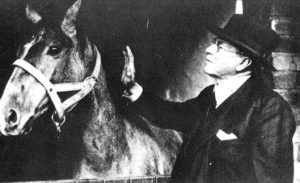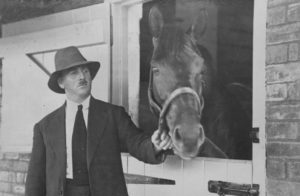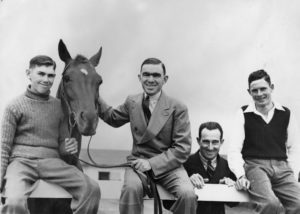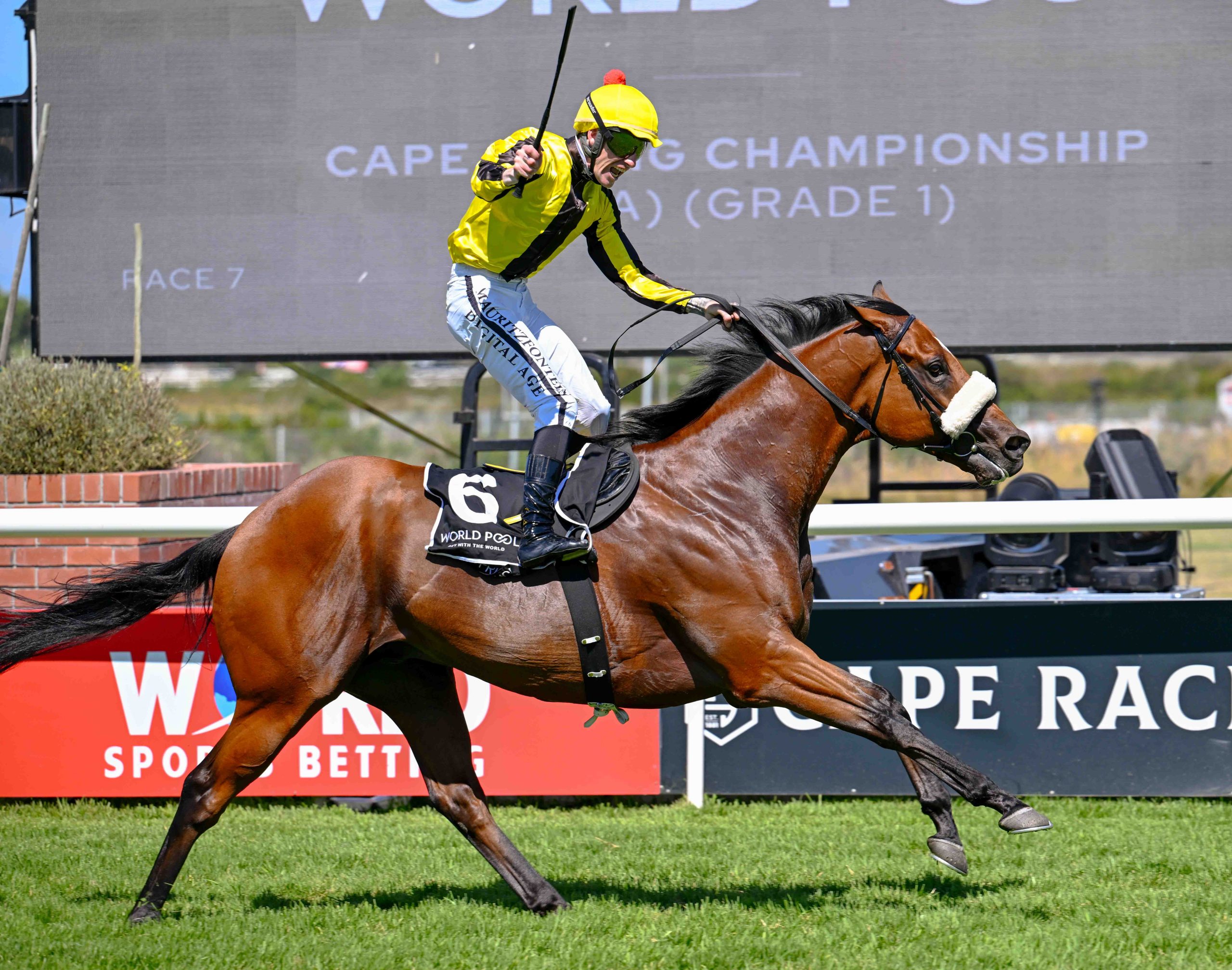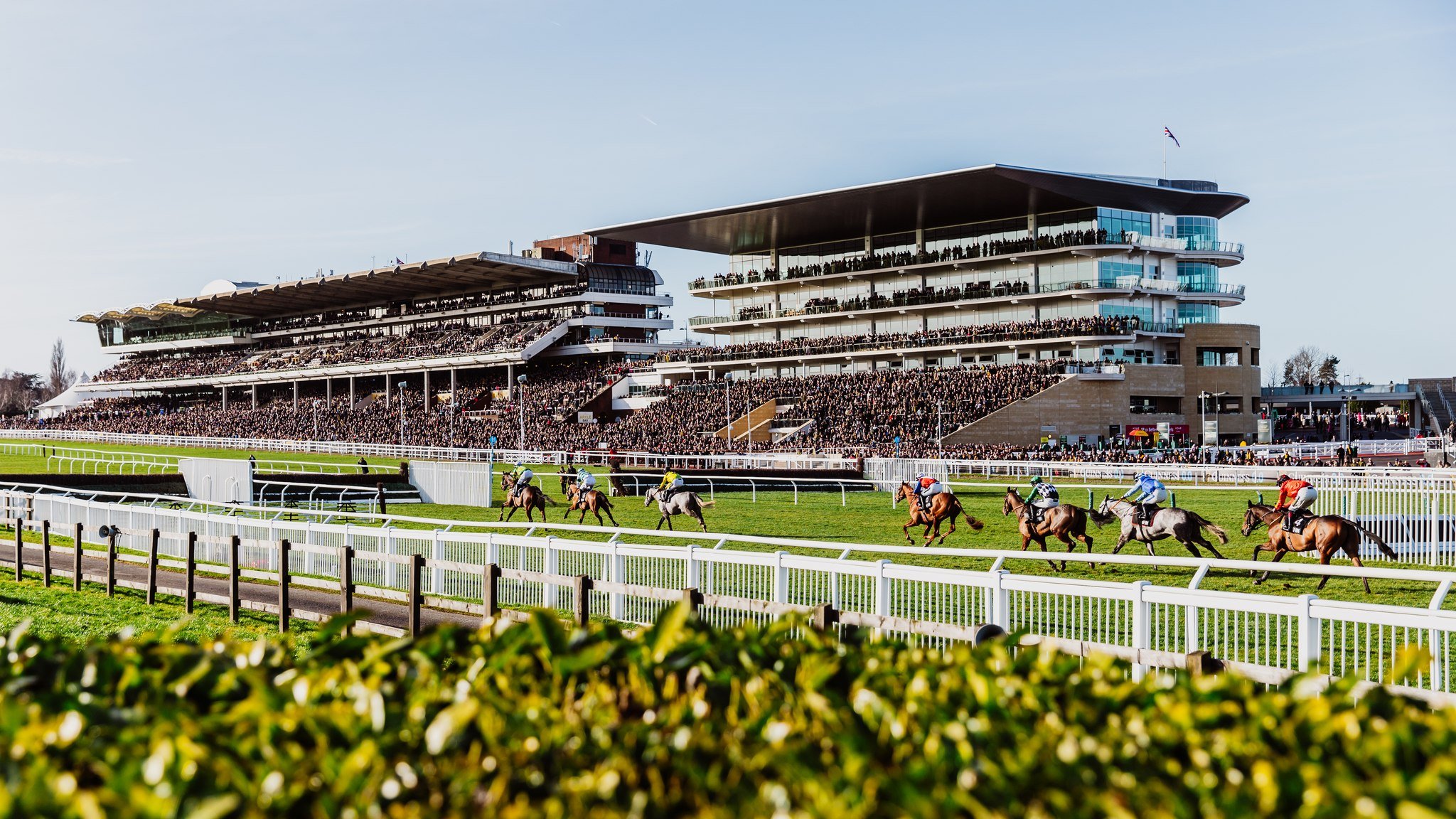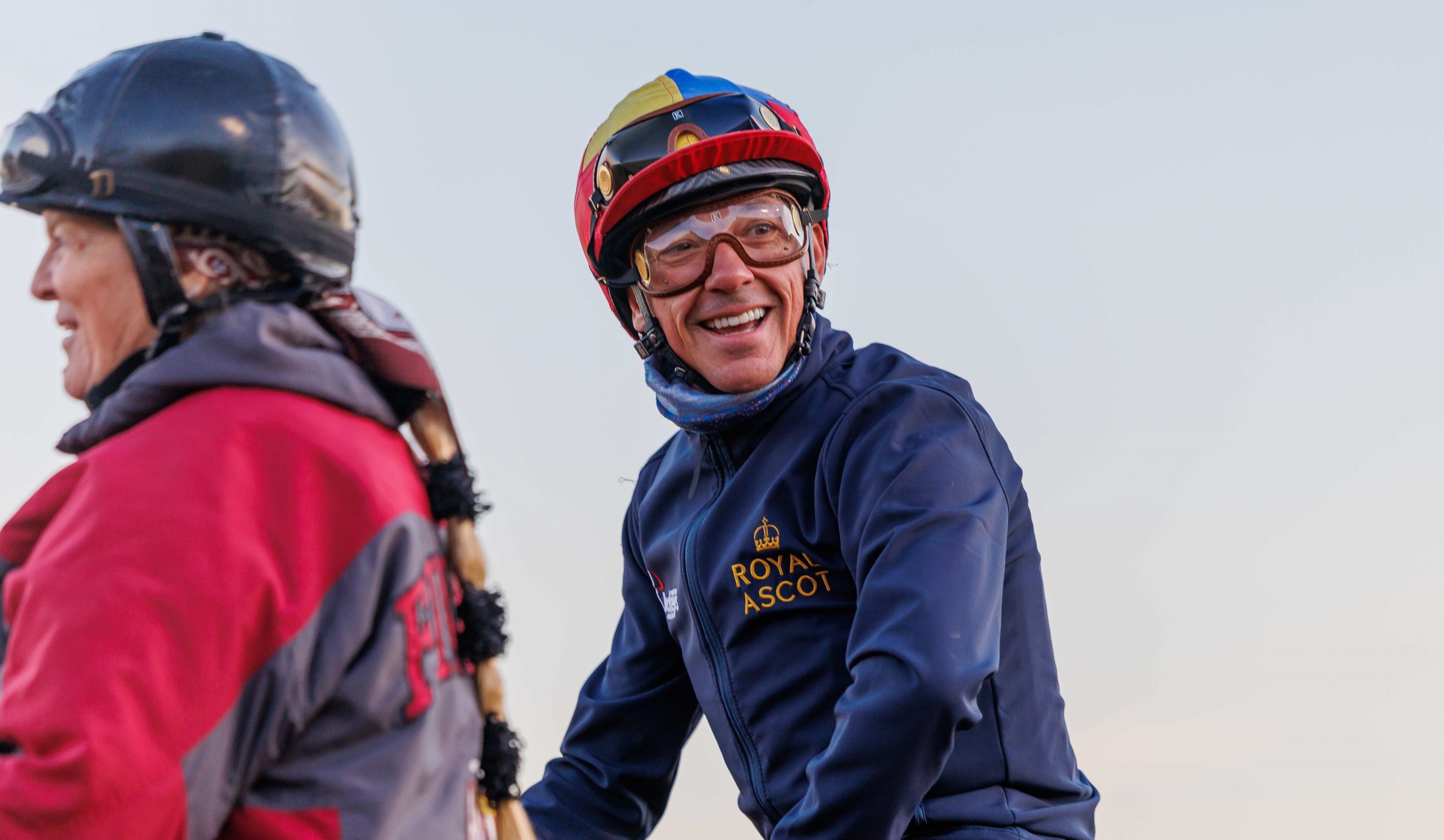According to racing historian Charles Faull, one of the greatest July stories never told is that of Full Dress. To unravel it, one needs to travel back in time all the way to 1903, the year Henry Nourse’s filly Peerless won the July. Make a note of the name, it comes up again later…..
Forgotten World Record
In 1903, A.E. Passmore went to the UK on honeymoon and during his stay, made time to acquire stock to start a stud in Bethlehem, which was to be named Forest Gate Stud. Included in his purchases was the stallion St Maurice, a two-time winner by St Simon out of Dorice, a daughter of Melton, who was one of the greatest broodmare sires in the world. The other notable purchase was a yearling filly named Pelerine. By St Angelo and also out of a daughter of Melton named Nun’s Cloth, the filly set him back the princely sum of 10 guineas.
Pelerine went on to win two minor races before retiring to stud and ‘A.E.’ mated her to St Maurice, joining the two strains of Melton. In 1909, the mating produced a chestnut colt named Van Raalte, who would go on to win the 1912 SA Derby.
Perhaps prompted by Van Raalte’s success, ‘AE’ repeated the mating and in 1913 Pelerine produced another chestnut, a filly this time, named Opera Cloak, who would go on to win the 1916 SA Oaks.
Now here’s where the story becomes a whole lot of fun. Opera Cloak was a diminutive filly, so much so that she was eligible for Galloway races. Accordingly, ‘AE’ chose to keep and race her for his own account and trained her himself. After a good win in a Flying Handicap at the Johannesburg Turf Club on 23 December, ‘AE’ entered her for the Oaks, to be run over a mile and a half on 30 December. While it is fairly remarkable for a mare to produce full siblings who both go on to be classic winners, the story gets more remarkable still. ‘AE’, who was in his fifties by now, held a gentleman rider’s license and in what must be a world record, AE is down in the history books as the breeder, owner, trainer AND rider of the 1916 Oaks winner, beating in the process, Ike Strydom, the champion jockey of his day. “That has GOT to be a world record!” exclaims Charles.
Inbreeding
Charles believes it is the close inbreeding to Melton which sparked this brilliance. “You don’t see horses hitchhiking up the N1 or anywhere else for that matter. In nature, selective imperative and geographical reach virtually guarantee close inbreeding. Here we have a very close inbreeding to Melton, one of the greatest broodmare sires of all time. We have two daughters of a great broodmare sire from the x-trail of the father to the x-trail of the mother. And the pattern is important to note because although inbreeding is defined as the duplication of a single ancestor, there are many forms of inbreeding.”
“Natural selection – survival of the fittest – is based on fighting and selecting for the biggest and strongest, whereas in Thoroughbred breeding, we use racing ability as the basis for selection. It’s an entirely unnatural selection process, which does not respect the natural order of things.”
Peerless
Now we need to take a short detour back to our 1903 July winner, Peerless, who has subsequently retired to stud. In 1908, Peerless produced a colt named Nobleman (Greatorex – Peerless), who goes down in history as being the only 2yo to win the July in 1911 when he was ridden to victory by Alec Laird, the father of Syd Laird and grandfather of our current Met winning-trainer, Alec Laird.
In 1910, mated to Minor Forfeit, Peerless produced a colt named Unequalled, who would go on to become a very successful sire in South Africa.
Jim Russell
Now we wind the clock forward a little to 1918, when the legendary Jim Russell wins the first of his three successive Julys. Russell’s first victory in the July came with the 5yo English horse Pamphlet, carrying a good weight of 122lbs to a 1.5 length victory as the 3-1 race favourite.
In 1919, Russell was back with a 6yo English import named Goldwing. Goldwing had shown early promise at 3 and 4, but gone wrong, perhaps due to his reportedly crooked legs. Russell took over the broken down horse and showing his famed skill as a horseman, turned Goldwing around to run in the 1919 July Handicap. Goldwing was backed down from 100-1 to second favourite. Carrying 96lbs and ridden by Russell’s 17yo apprentice Syd Garrett, Goldwing won by half a length from Sir Abe Bailey’s beautifully bred English import, Polychromy, who was by the world champion sire, Polymelus. The young Garrett caught the attention of the racing world by bringing home the heavily backed favourite to give Russell his second successive July win.
He shot to prominence even more the following year, when he reigned supreme on the mighty Pamphlet, carrying 9st 8 (134 lbs) and conceding 27lbs to his nearest rival Polygamist (another son of Polymelus) with an impost of 7st 9 (107 lbs), to win by an official one and a half lengths (although the finish photograph suggests considerably more).
Russell was victorious at Greyville for a 4th time in 1923, when he won it with Eunomea, ridden by J Otto with a postage stamp weight of 6st 6 (90 lbs). Within three years of Eunomea’s win, Jim Russell had emigrated to England, however, his South African legacy lived on and his fingerprints lie thickly strewn across our history and stud book, for those who know where to look.
Enduring influence
Russell departed South Africa for the UK in 1925. He trained in the USA for approximately a year, before going back to England.
In the interim, the weights had caught up to Syd Garrett, and by the age of 23, he had hung up his boots and taken out his trainer’s license. Garrett is widely considered the greatest horseman South Africa has ever seen, but it is worth remembering that he learned his craft from Jim Russell. Garrett was a mere 24 years old when he trained the first of his ELEVEN Met winners in 1926, with Sir W Nelson’s Grand Chase.
South Africa felt the influence of Russell again via the English horse, Hussein. Russell recommended the purchase of the horse to JWS Langerman and Hussein went on to win the 1927 Metropolitan and then followed up by winning the 1927 Durban July, ridden by Granville Gorton of Noreen Stud fame.
Now we move along to the late 1920’s. Thanks, yet again, to that man Russell, Garrett purchased a grey horse named Roamer. Roamer’s splayed feet and awkward gait earned him the unflattering nickname of ‘Pikkewyn’ among the stablehands. However, Roamer had the last laugh, winning the 1928 Met under Jackie Gorton and the 1929 Met with Stanley Gorton in the irons. The back to back victories earned his trainer his famous moniker ‘The Wizard of Roamer Lodge’.
Turning the calendar page to 1930, Garrett arrived at Greyville with 2 runners for that year’s July – the 5yo Roamer, with an impost of 9st 11lbs (137 lbs) and a 6yo horse named Full Dress, carrying 8st 11lbs (127 lbs). Stanley Gorton was engaged to ride Roamer and Cookie Amos was on Full Dress.
Charles confides, “Cookie told me Abe Bailey’s horse The Andes was 7-2 favourite, carrying a postage stamp 6st 10lbs (94 lbs) and Roamer was 2nd favourite. Garrett told all his friends, “If you back Roamer, back him on the Tote. To win at that weight, he would need to be a Pamphlet and he’s not Pamphlet.”
Full Dress Story
The Full Dress story is recounted by Charles and pieced together from several interviews conducted with Stanley and Cookie Amos.
Full Dress was bred by AE Passmore at his Forest Gate Stud in the Free State in 1923. ‘AE’ trained the colt himself as a 2yo and he went on to be one of the best of his generation, winning amongst others, one of the most important 2yo races in Johannesburg, the Gosforth Park 2yo Plate, under AE’s son, A Passmore. He also finished 2nd in the African Breeders Plate at Greyville giving 17lbs to the winner, War Office, beaten ¾ of a length. Garrett noticed and remembered that.
At the end of his 2yo career, AE Passmore sold Full Dress to prominent owner Mr N Friedman, who transferred the horse to trainer J Jamieson. Sparingly raced at 3 and 4, Full Dress won over 5 furlongs at Turffontein in April 1927. He was half a length 3rd to Hussein in the 1927 July (run over 2000m at the time), ran a good third in the 1928 Johannesburg Merchants (beaten only a neck into third) and third in the 1928 Summer Handicap, and was sold shortly afterwards to Mr H.O. Yates.
Whilst in the ownership of Yates, Full Dress was campaigned mainly as a speed horse and after a series of unplaced runs in Durban and Johannesburg, the horse was brought to Cape Town, where he managed places in the Rosmead Handicap (ridden by Cookie Amos) and the top division March Handicap under Jackie Gorton.
Back to life
At this point, 27yo Syd Garrett, who remembered the horse’s 2yo form, bought the horse at a second hand sale, and got to work. The Amos’ were adamant that when he arrived at the stable, as a 6yo entire, Full Dress was unsound and not striding out well. After some TLC from the Wizard of Roamer Lodge, Full Dress showed that he was definitely not a sprinter / miler and the next bit happens rather quickly. On 5 April, giving away 13lbs, he was just touched off in a top division 10 furlong at Kenilworth. On 21 April, he won the 1800m Easter Handicap at Kenilworth under Cookie Amos and made it a double in the 24 May Ascot Cup at Milnerton over 2000m under the second top weight of 120lbs and giving away 24lbs to the second placed Sanadin. Then Garrett entered him for the Durban July.
Charles shakes his head incredulously. “It shows you the genius of the man. He brought the horse back to life and within 3 months had him ready for the July!”
“He was confident of a big run. Garrett’s horses didn’t start at 33-1 if they were confident, let me tell you. Although he was still young and hadn’t refined his methods yet, he was intensely aware of weight, particularly over distance. They judged horses in terms of stones and to them 9 stone was a top class horse. Cookie told me that Full Dress improved dramatically when Garrett took him over – he really made that point – and going into the July, he was working very well.”
“Roamer was a very good horse and they felt Full Dress was not far off. Garrett said, ‘Full Dress is working well with Roamer, you’ve got to respect him. He’s getting a stone from Roamer and you’ve got to respect that.’”
As it happened, on 5 July 1930 Full Dress won the July in a fight by a neck from Southern Lad. It’s worth noting that Full Dress carried 123lbs, beating the second placed 4yo UK import carrying 99lbs – in other words, conceding 24lbs. Stablemate Roamer ran unplaced.
Although Garrett had won the July twice as a jockey, the 1930 July was his first as a trainer and he was also the registered owner of Full Dress. However, it was to be the start of his huge influence over the history, not only of the July, but South African racing as a whole.
To close off and bring our story full circle, it bears explaining that Full Dress was by the good South African sire, Unequalled (Minor Forfeit – Peerless) bred by ‘EA’ Passmore’s record-setting Oaks heroine, Opera Cloak.




